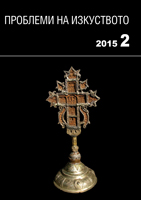
We kindly inform you that, as long as the subject affiliation of our 300.000+ articles is in progress, you might get unsufficient or no results on your third level or second level search. In this case, please broaden your search criteria.















Although intended for the Christian temple, ecclesiastical woodcarving represents compositions influenced by the Folklore and the ancient Eastern mythology. It contains images of sirens, unicorns, centaurs, sphinxes, etc., but the lamias (dragons) are the most interesting among them. They appear on the royal gates, by the Crucifix, on the columns and woodcarving panels, etc. These teratological motifs offer very different mythological-folklore interpretations: the lamias as apotropaic sign, as chtonic creature, representing the great Mother-Earth, as one participant of the dual nature of the world, etc. Only in the late iconosthasis (the end of the 19th century and during the 20 century) the lamia appears according to the orthodox Christian ideas as a symbol of evil or Satan, but that means the end of the great epoch of the ecclesiastical woodcarving and its symbolic importance.
More...


The topic approached in this study involves identifying the particular notes of Father Daniil Sandu Tudor’s akathist-hymns, mystic poet (neohymnologist) of the Romanian Orthodox Church - by applying a hermeneutic from the perspective of iconic anthropology structure. The fact that the akathist-hymns were accepted by the Romanian Orthodox Church in her liturgical corpus and are thus enjoying the status of sacredness, specific to the religious texts, requires the identification of appropriate ways of reception of this type of creation. Knowledge, in the neo hymnologist poet’s point of view, does not have much in common with the exercise of reason because the ultimate goal is deification. But even if you take the world transcendental teleological support, it can be achieved only by our way of thinking and behaving in the real world. The relation between immanence and transcendence clearly derives both from the dual nature of Jesus Christ and God’s Trinitarian status. The sacrificial and redemptive Cross - Christian symbol and sacral value - necessarily requires the supreme sacrifice model, which is the one of the Savior’s crucifixion, model that intermediates the relation between heaven and earth, between immanence and transcendence.
More...
My assertion is that God’s biblical image may not reflect entirely His existence in itself as well as His revealed image. Even if God in Himself is both transcendent and immanent at the same time, and He is revealing accordingly in the history of humankind, still the image of God constructed in the writings of the Old Testament is merely the perspective made upon God by His followers to whom the He has revealed. That could be the reason why for centuries God’s biblical image seems to emphasize more His immanence, starting with Pentateuch, where God cohabites with Adam on Earth, then He reveals Himself to Abraham and Moses and so on. Somewhere, after the Babylonian exile, the image suffers slightly differences tilting towards God’s transcendence. In a path already created and grounded by Israel’s ancestors, even this new color of transcendence bears the nuances of immanence. How can this be possible? Let’s take a look on the revelation received by Abraham from God and see how this can fit the profile. Instead of the transcendence of God regarded by others in the differentness of Yahweh appointed by Abraham in his walking out of Mesopotamia, I will prove otherwise, that Abraham is on the contrary proving God’s immanency in this very differentness of His in relation with other gods by providence and omnipresence, indwelling His creation.
More...
I have started this research as a response to a pejorative question that religious rituals are merely theatrical, and the personnel involved nothing else but actors; beyond this there is nothing any religion suggests, e.g. healing, divine touch, blessings et.al. This paper is about rituals and their meanings and roles played as in social drama and theatre play. Considering the relationship between ritual and theatre to be reciprocal I will use their functions to evaluate the process of religious ceremonies and the role they play for adherents/participants, as if they would be attending a play. Religious Studies and Drama joint study offers the opportunity to combine two complementary humanities subjects, as both drama and religion are mainstays of cultural practice.
More...